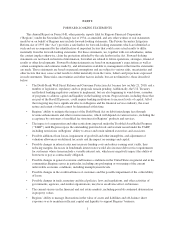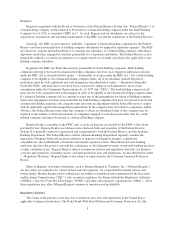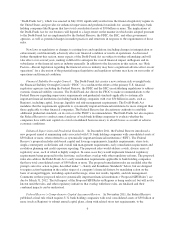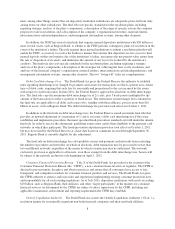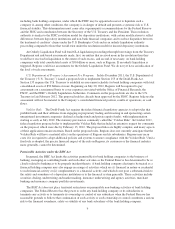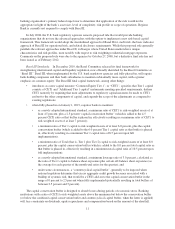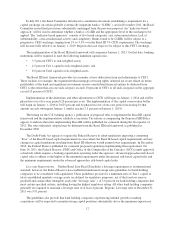Regions Bank 2011 Annual Report Download - page 32
Download and view the complete annual report
Please find page 32 of the 2011 Regions Bank annual report below. You can navigate through the pages in the report by either clicking on the pages listed below, or by using the keyword search tool below to find specific information within the annual report.must, among other things, ensure that our depository institution subsidiaries are adequately protected from risks
arising from our other subsidiaries. The final rule sets specific standards for the resolution plans, including
requiring strategic analysis of the plan’s components, a description of the range of specific actions the company
proposes to take in resolution, and a description of the company’s organizational structure, material entities,
interconnections and interdependencies, and management information systems, among other elements.
In addition, the FDIC has issued a final rule that requires insured depository institutions with $50 billion or
more in total assets, such as Regions Bank, to submit to the FDIC periodic contingency plans for resolution in the
event of the institution’s failure. The rule requires these insured institutions to submit a resolution plan that will
enable the FDIC, as receiver, to resolve the bank in a manner that ensures that depositors receive access to their
insured deposits within one business day of the institution’s failure, maximizes the net-present-value return from
the sale or disposition of its assets, and minimizes the amount of any loss to be realized by the institution’s
creditors. The final rule also sets specific standards for the resolution plans, including requiring a strategic
analysis of the plan’s components, a description of the strategies for achieving the least costly resolution, and
analyses of the financial company’s organization, material entities, interconnections and interdependencies, and
management information systems, among other elements. The two “living will” rules are complementary.
Debit Card Interchange Fees. The Dodd-Frank Act gives the Federal Reserve the authority to establish
rules regarding interchange fees charged by payment card issuers for transactions in which a person uses certain
types of debit cards, requiring that such fees be reasonable and proportional to the cost incurred by the issuer
with respect to such transaction. In June 2011, the Federal Reserve approved its final rule on debit interchange
fees. The final rule caps the maximum debit interchange fee at 21 cents, plus 5 basis points (multiplied by the
amount of the transaction) to reflect a portion of fraud losses. The restrictions on interchange fees contained in
the final rule are applicable to all debit card issuers who, together with their affiliates, possess more than $10
billion in assets, such as Regions Bank. The debit interchange fee provision took effect on October 1, 2011.
In addition to the final rule on debit interchange fees, the Federal Reserve issued an interim final rule that
provides an upward adjustment of a maximum of 1 cent to an issuer’s debit card interchange fee if the issuer
establishes and implements procedures that meet specified fraud-prevention standards set forth under the interim
final rule. In order to receive the adjustment, qualifying issuers must certify their eligibility to the payment card
networks in which they participate. The fraud-prevention adjustment provision took effect on October 1, 2011,
but may be revised by the Federal Reserve at a later date based on comments received through September 30,
2011. Regions Bank is currently eligible for this adjustment.
The final rule on debit interchange fees also prohibits issuers and payment card networks from restricting
the number of payment card networks on which an electronic debit transaction may be processed to fewer than
two unaffiliated networks, regardless of the means by which a transaction may be authorized. This network
exclusivity provision is applicable to all issuers, even those exempt from the debit interchange fees. Issuers will
be subject to the network exclusivity rule beginning on April 1, 2012.
Consumer Financial Protection Bureau. Title X of the Dodd-Frank Act provides for the creation of the
Consumer Financial Protection Bureau (the “CFPB”), a new consumer financial services regulator. The CFPB is
directed to prevent unfair, deceptive and abusive practices and ensure that all consumers have access to fair,
transparent, and competitive markets for consumer financial products and services. The Dodd-Frank Act gives
the CFPB authority to enforce and issue rules and regulations implementing existing consumer protection laws
and responsibility for all such existing regulations. As of July 2011, depository institutions with assets exceeding
$10 billion, such as Regions Bank, their affiliates, and other “larger participants” in the markets for consumer
financial services (as determined by the CFPB) are subject to direct supervision by the CFPB, including any
applicable examination, enforcement and reporting requirements the CFPB may establish.
Orderly Liquidation Authority. The Dodd-Frank Act creates the Orderly Liquidation Authority (“OLA”), a
resolution regime for systemically important non-bank financial companies and their non-bank affiliates,
8





